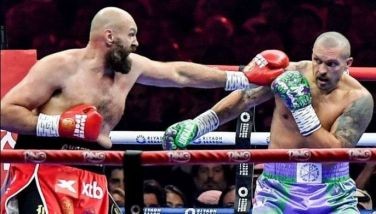An honest assessment
The Asian Games have once again come to a close, and we are turning away from the sports pages once again wondering why we have not improved on past performances. Aside from the terrible cheating in boxing, many Filipino sports fans did not really know who was competing for the country. Those on the ground in Incheon did a yeoman’s job of trying to get as many Filipinos as possible up to speed on who our contenders were, and how they were doing. Even social media seemed to be at a disadvantage, with friends and family members trying to enlighten the public on the impending achievements of our athletes. Everybody just jumped on the bandwagon towards the finals of each event, not really a healthy way to support the cause.
In this regard, we in the sports media have to make the effort to be less hamstrung about making deadlines and being “newsworthy,” and more geared towards preparing audiences for major sporting events, in basketball, this is a piece of cake with the natural popularity and media pipelines of the PBA and UAAP. It has already become a habit for fans to know (or even independently learn) about players, teams and even changes in rosters, we have to do a better job of educating the public about our own athletes. What have their accomplishments been? How did they prepare for this event? How do they stack up against the field?
Particularly when a national athlete is based outside of the Philippines and out of immediate reach of the beat reporters and columnists, our own sports media has to come up with a way to keep the public updated. This will build interest in multisport competitions like the Asian Games and SEA Games, and also train the public to brush up on who is playing what sport on the national team. In the last four years, the fan base of soccer has grown, and a lot of it is propelled by the fans themselves.
We also have to seriously not expect miracles if our athletes are already competing handicapped. If they don’t have the same level of training as their competitors, then how can we conceivably expect the same results? Our parameters would have to drastically change. We need to know what the rest of the world is doing. If they have adopted certain training techniques and we haven’t, how can we expect to produce the same results? The answer is simple, we can’t. It’s insane to do something differently then expect the same result.
Research is a primary tool that we are not fully availing ourselves of. Rarely do we see the records of our competitors and our own athletes, unless it is the Olympics where many opponents are world or Olympic record holders. You can’t get from point A to point B if you don’t know where you’re heading. In many disciplines where times and scores are the determinants, this is easier to calculate. But in contact sports and team sports, this is at best an inexact science. Comparing past opponents would be the next best thing. That’s probably why Daniel Caluag’s gold medal in BMX surprised a lot of us. Some Filipino sports fans have even told this writer that they didn’t know which sports we were even competing in, which is sad.
The system’s foundations have to change, too. There is no synchronicity between tenures among officers of the Philippine Olympic Committee and the Philippine Sports Commission. POC board members are voted into position every Olympic cycle, or every four years. The loophole is that many national sports associations (NSAs) hold elections every year, which could cause a very unusual situation. A sitting POC board member may not even be representing an NSA for most of his or her term. Meanwhile, the PSC board members, directly under the Office of the President, are in an even more precarious position. They may be replaced at any time. And even if they are not, out of delicadeza, they submit courtesy resignations to the succeeding Chief Executive. The great majority of the time, they are replaced, no matter the grandeur of their accomplishments or the significance of their programs.
What this means is that there has been a critical lack of continuity in the way our sports have been handled, the way programs are being prepared. Six years is not really enough time to produce world or Olympic champions. Statistics have shown that 10,000 hours is the yardstick for world-class performance in any field. That’s equivalent to three hours of practice a day for ten years. That doesn’t include diet, coaching, drills and even talking strategy. Are the athletes getting optimal diet and sleep supervision? Are they full-time athletes, or mentally just part-time, and the rest of the time thinking of how to augment their meager allowances. All of these things matter.
At the end of the day, we have another chance at starting over, at wiping the slate clean, at working with the next generation of athletes. But let’s take a new tack in this. We have another four years before the next Asian Games, and there is really only one question: what will change?
- Latest
- Trending































